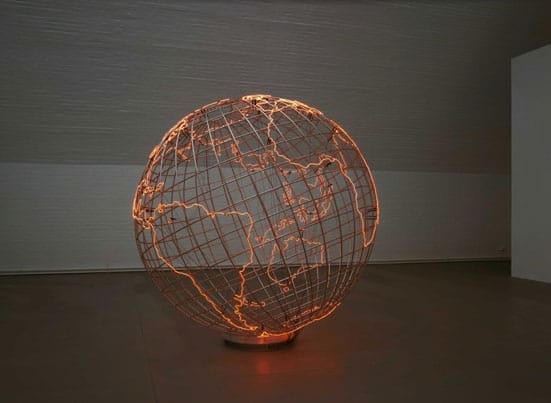24th November 2006 — 22nd December 2006
The
White Cube landed in Mayfair earlier this year and it still looks like
an alien visitor. Beamed from the outer reaches of Hoxton straight to
the centre of establishment art, it rubs shoulders with antiques
dealers, antiquarian booksellers and a giant branch of Christie's. The
effect of walking through staid St James' to reach this gleaming
mothership of cool is likely to colour the experience of any exhibition
you see here. It certainly adds to uncomfortable sensations provoked by
Mona Hatoum's first solo show in London since 2002.
Well-known as a purveyor of alienation and despair, an artist
who delights in turning kitchen utensils into instruments of torture,
Hatoum's many fans won't be disappointed by the five works on display
at Mason's Yard. For the newcomer, one piece in particular is likely to
stand out. Lending its title to the whole show, Hot Spot is by far the
most exciting thing here. A steel globe with the continents outlined in
neon, it completely dominates the massive ground floor space. Casting a
malevolent orange glow and fizzing with electricity, it manages to be
both unsettling and mesmerising at the same time. It's a trademark of
Hatoum that the objects she creates are (or appear to be) genuinely
dangerous and you'd probably fry if you touched this piece of art. The
nervous glances of the gallery staff as I drew near to it may, for
once, have been out of concern for my safety rather than that of the
work.
On the wall nearby a two-dimensional map of the world in cotton and
abaca hangs unassumingly. Pale, soft and politically correct (it
follows the Peters Projection, which shows countries in proportion,
rather than squashing up the southern hemisphere), it acts as a nice
foil to the hissing intensity of the decidedly angry globe.
The basement is given over to Web, a giant, sagging spider's web decked
with hundreds of glass balls which look like drops of dew. It might
well have a lot to say about interconnectedness and fragility, but
there's something cartoonish and unsatisfying about it. Perhaps I'm
being unfair: coming after Hot Spot, even the most vivid artwork would
probably look a little washed-out.
In an adjoining room Hatoum returns to a favourite theme with Cube, a
heavy iron cage, apparently the height of the artist herself. There's
no gate or lock, just a dense metal lattice, more the idea of a prison
than anything real. On the wall opposite hang more maps, this time
taken from the middle pages of in-flight magazines. Hatoum has doctored
them, filling the segments created by the criss-crossing air routes
with bright colours. The effect is almost psychedelic. But the problem
with this third and final section is the setting - it's an awkward,
leftover space next to a lift, cluttered with fire extinguishers.
It's easy to read Hatoum, a Palestinian who was born and grew up in
Beirut, as a spokesperson for her people, channelling their particular
sense of dislocation and injustice. She is on record, however, as
saying that her aim is to reflect much more general aspects of the
human condition. So Hot Spot and the objects gathered together in its
name can be seen as a foray into more overtly political territory. The
title, the use of maps, the idea of a world on fire, these are themes
that go beyond her usual preoccupations with the dark side of the
domestic. It's not surprising, perhaps, given the constant diet of
conflict fed to us through newspapers and television screens at the
moment. Hot Spot is a show for hot times.
DS
White Cube - Mason's Yard
25-26 Mason's Yard
London SW1Y 6B
http://www.whitecube.com
Open
Tuesday-Saturday, 10am-6pm

Mona
Hatoum
Hot Spot 2006
Stainless steel and neon tube
Dimensions to
be confirmed
© the artist Courtesy Jay Jopling/White Cube, London
and Galerie Max Hetzler, Berlin